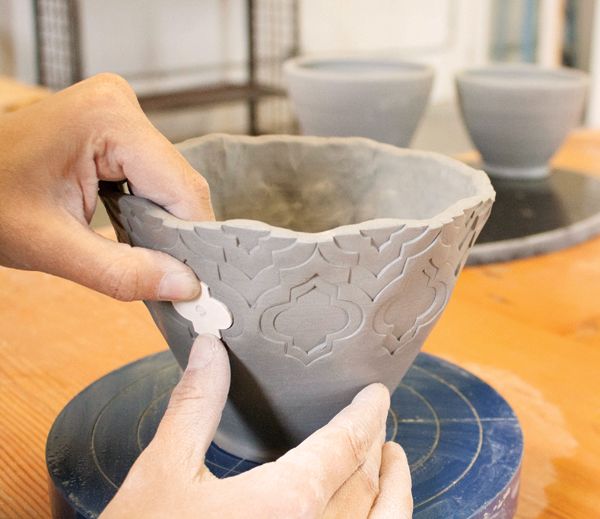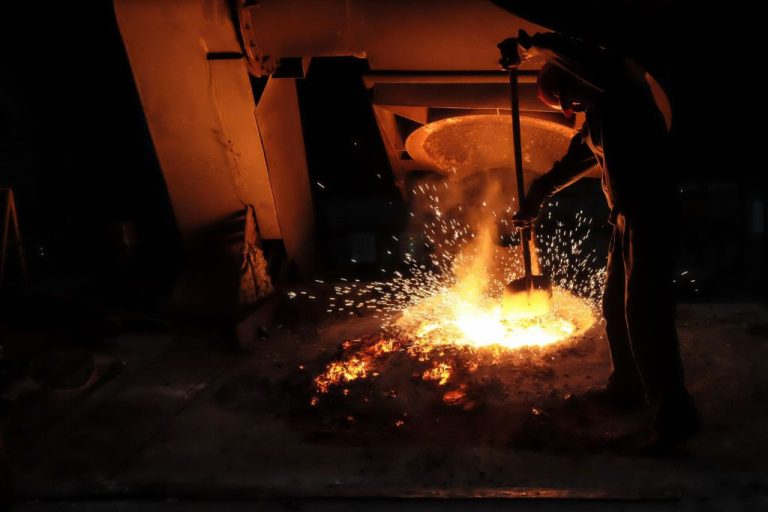How Is Raku Different From A Normal Firing?
What is Raku?
Raku is a style of low-fired pottery that originated in Japan in the 16th century. The term “raku” comes from the Japanese word “raku-yaki” which means “enjoyment ware” (Wikipedia). Raku ware was traditionally used by Japanese tea masters for tea ceremonies.
Raku firing involves removing pottery from the kiln while it is still glowing hot, usually around 1800°F. The pottery is then placed into containers filled with combustible materials like sawdust or leaves. This causes incomplete oxidation and allows cracks and carbon trapping to form distinctive patterns on the surface (Soul Ceramics).
The rapid cooling and reduction process leaves distinct crackle glazes and smoked effects on raku ware. Raku pottery often has an earthy, organic aesthetic distinguished by its unpredictable cracks and textures.
Raku Glazes
Raku glazes have unique properties that distinguish them from other ceramic glazes.
Raku glazes are formulated to withstand the thermal shock of the raku firing process. They have special compositions with high silica and low alkali content that allow them to survive quick cooling without cracking. The glazes remain durable but are more porous and prone to crazing compared to traditional glazes (https://www.britannica.com/art/raku-ware).
Typical raku glazes include lead glazes, colored glazes like reds and oranges, and crackle glazes. Lead glazes contain metals like copper, iron, or cobalt to produce metallic colors through oxidation. Reds and oranges are achieved through the addition of copper. Crackle glazes use materials like dolomite and calcite to induce cracking patterns. Raku glazes can also incorporate stains, mason stains, underglazes, and overglazes to create layered effects.
Compared to traditional glazes, raku glazes have more variability in the final results depending on factors like firing temperature, atmosphere, and cooling rate. The raku process purposely induces incomplete oxidation and cooling to create unique iridescent, crackled, and carbon trapping effects in the glaze (https://japanobjects.com/features/rakuware). This unpredictability is part of the appeal of raku ware.
The Raku Firing Process
The raku firing process differs significantly from normal firing techniques. According to Soul Ceramics, raku firing takes only 1-2 hours compared to regular firing which can take up to 24 hours. There are several key steps involved in raku firing:
First, the kiln is heated rapidly to around 1800°F. Pieces are fired at this high temperature for a short time, usually 5-15 minutes. This bakes the clay but does not completely fuse the glaze.
Next, the red hot pottery is removed from the kiln using long metal tongs and placed into containers filled with combustible materials like sawdust or leaves. This produces a reduction atmosphere which alters the glaze colors and causes crackle patterns.
According to Kiln Frog, the pots are left in the reduction chamber for about 20 minutes. Smoke penetrates the crackled glaze and leaves carbon deposits that create the distinctive raku finish.
Finally, the pieces are plunged into water or sometimes buried in sand or ash. This rapid cooling fixes the glaze effects. The raku firing process creates unique finishes not possible with normal high-fire techniques.
Removing Pots from the Kiln
Unlike normal firings where pots are allowed to cool slowly inside the kiln, in raku firing the pots are removed from the kiln at peak temperature, which is around 1800°F (982°C). This is one of the key differences between raku and traditional firing methods.
To remove the extremely hot raku pots, long metal tongs are used along with heavy duty gloves. The pots have to be quickly yet carefully taken out of the kiln and transferred to containers filled with combustible materials like sawdust or leaves. This rapid cooling and reduction atmosphere is what gives raku glazes their distinctive crackled and unpredictable effects. If raku pots were left to cool slowly inside the kiln like normal firings, the results would not achieve the same aesthetic.
As the Lakeside Pottery Raku Workshop Guide explains, “Current process of Raku: Pots are fired to 1800F degrees. At that time, the pots are carefully removed, with long tongs, and placed in a special paper lined container with combustible materials. The container is then covered with a lid to extinguish the flames and start the reduction process.”
The raku potter must work swiftly when removing the pots at peak temperature. The process requires speed, coordination, and care to transfer the extremely hot raku ware into the reduction chamber without damaging the pots. This rapid transfer from kiln to reduction is integral to the unique raku process.
Post-Firing Reduction
After the pottery is removed from the raku kiln at around 1,800°F, it undergoes a rapid post-firing reduction process. This technique, unique to raku, involves placing the extremely hot pottery into containers filled with combustible materials like sawdust or newspaper (https://thepotterywheel.com/how-to-raku-fire/). The materials ignite and start smoking heavily.
The containers are then quickly covered, starving the burning material of oxygen. This smoking process is key to raku’s distinctive crackled and lustrous metallic finishes. According to raku resource http://raku-art.com/common-myths-about-raku/, the reduction atmosphere created by the smoke deposits carbon into the cracked clay.
After 10-20 minutes in reduction, the pottery undergoes rapid cooling by quenching in water. This extreme thermal shock from quickly moving between high heat and water fixes the carbon in the clay and enhances the crackle patterns that give raku its unique aesthetic.
Incomplete Oxidation
One of the key factors that makes raku firing different is the effect of incomplete oxidation on the colors and textures of the finished pieces. Oxidation refers to the process by which oxygen reacts with the glazes and clay during firing. In normal pottery firings, the goal is to achieve complete oxidation by ensuring sufficient airflow inside the kiln.
In raku firing, pots are removed from the kiln and subjected to a post-firing reduction process. This reduction environment has very limited oxygen available. The lack of oxygen leads to incomplete oxidation of the metals in the raku glazes, causing unique coloring effects. Colors that range from the darker copper reds, cobalt blues, and purples are a hallmark of reduction effects on raku glazes.
The reduction process also creates interesting crackle patterns and textures on the surface. So the intentional creation of an oxygen-starved environment is key to achieving the distinctive raku aesthetic.
Cracking Patterns
One of the hallmarks of raku pottery is the distinctive cracking patterns that form on the surface. These cracks are caused by thermal shock during the rapid cooling process. When the extremely hot raku pots are removed from the kiln and placed into boxes filled with combustible materials like sawdust or leaves, the temperature drops dramatically, causing the glaze to crack apart.
The glazes used in raku are specially formulated to enhance cracking. As the clay body and glaze cool at different rates, the glaze is unable to contract fast enough, resulting in a crazing effect. Raku glazes have a high thermal expansion coefficient, meaning they expand more than typical glazes when heated and contract more rapidly when cooled. This difference in expansion between the body and glaze is what creates the distinctive cracking.
The patterns and designs that form are unique to each raku firing. Factors like the thickness of the glaze, types of materials used for cooling, and speed of cooling will all affect the look of the cracks. The random nature of the process means that no two raku pieces will crack in exactly the same way. Many raku artists appreciate these one-of-a-kind patterns and textures that emerge from the firing.
Wax resist can also be used prior to glazing to create patterns by blocking the glaze from adhering to certain areas(Source). When cooled, the wax melts away leaving the bare clay exposed in sharp contrast to the crazed glaze. Raku’s distinctive cracking is an integral part of the aesthetic that makes it unique from other ceramic firing techniques.
Mixed Media
One unique aspect of raku is the ability to incorporate other materials into the finished pieces beyond just clay and glaze. This is referred to as mixed media in the raku firing process. Common mixed media materials used in raku include horsehair, feathers, plants, paper and more.
Horsehair is a popular material to incorporate. The hair burns out in the post-firing reduction process, leaving behind fine carbon trails and patterns. According to Raku Pottery – Mixed Media by Karen Pierce, the horsehair can create intriguing carbonized impressions. Artists will often apply the horsehair by wrapping or pressing it against localized areas after removing the pot from the raku kiln while the piece is still glowing hot. This allows the hair to burn in specific patterns as it carbonizes.
Other organic materials like feathers and leaves can be applied in a similar fashion to create carbonized prints and trails. The unique patterns this mixed media approach creates is part of what defines the raku aesthetic.
Contemporary Raku
Raku has seen a resurgence in popularity among contemporary ceramic artists who appreciate the spontaneity and serendipity of the raku firing process. While raku originated centuries ago in Japan as a utilitarian pottery tradition, today’s raku artists have taken the technique in new creative directions.
Contemporary raku artists blend a variety of cultural influences and experiment with innovative methods. Some incorporate mixed media like paper, fiber, and found objects into their raku pieces (Tien Wen). Others layer multiple firings and post-firing treatments to achieve complex surfaces and patterns. Non-functional raku sculpture and installation art have also emerged as galleries showcase large-scale contemporary works.
The raku firing itself offers endless opportunities for innovation. Modern raku artists play with the timing, temperature, and chemical reactions involved. They have pioneered techniques like horse hair raku, where horse hair interacts with the glaze to create fuzzy black carbonized patterns. Contemporary works also showcase crackle effects, metallic lustres, and accidental features resulting from the firing process.
While honouring raku’s handmade pottery roots, today’s artists prove that raku continues to be a fresh, unpredictable, and globally inspired ceramic art form.
The Raku Aesthetic
Raku pottery is highly valued for its one-of-a-kind visual qualities that result from the raku firing process. The most distinctive features of raku aesthetics include the pottery’s crackled and crazed surfaces, variegated coloring, and imperfect shapes.
The raku firing and post-firing reduction stages introduce spontaneity into the pottery’s final appearance. As the pottery undergoes rapid cooling, the glaze crackles and crazes, creating web-like crackling patterns. The glaze also blisters and bubbles from trapped gases, adding texture. Raku glazes produce vibrant, mottled colors as the glaze interacts with smoke and flame during reduction. Pieces may exhibit copper green, deep blues, brick reds, or metallic gold.
Raku pottery embraces asymmetrical shapes and warped or sagging sides resulting from the firing. Pots often appear handmade and organic rather than mechanical and perfect. The raku aesthetic celebrates these imperfections as part of the pottery’s rustic expression. Marks from finger smudging and tool handling may remain visible.
Overall, raku pottery reflects naturalness, simplicity, and tranquility in harmony with Japanese aesthetic principles. The striking crackle glazes, uneven colors, and imperfect forms exhibit the beauty of transience and the passage of time.



